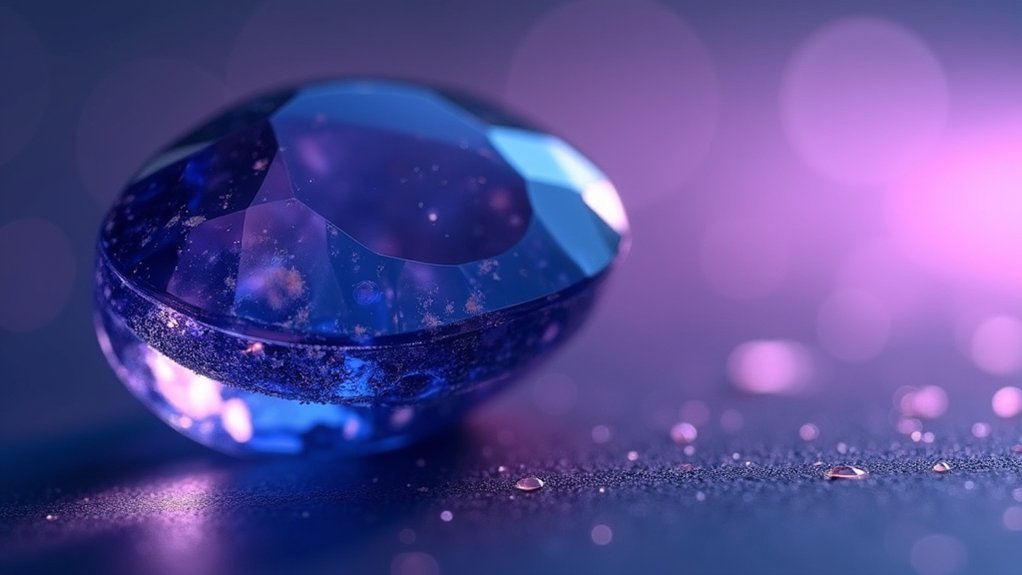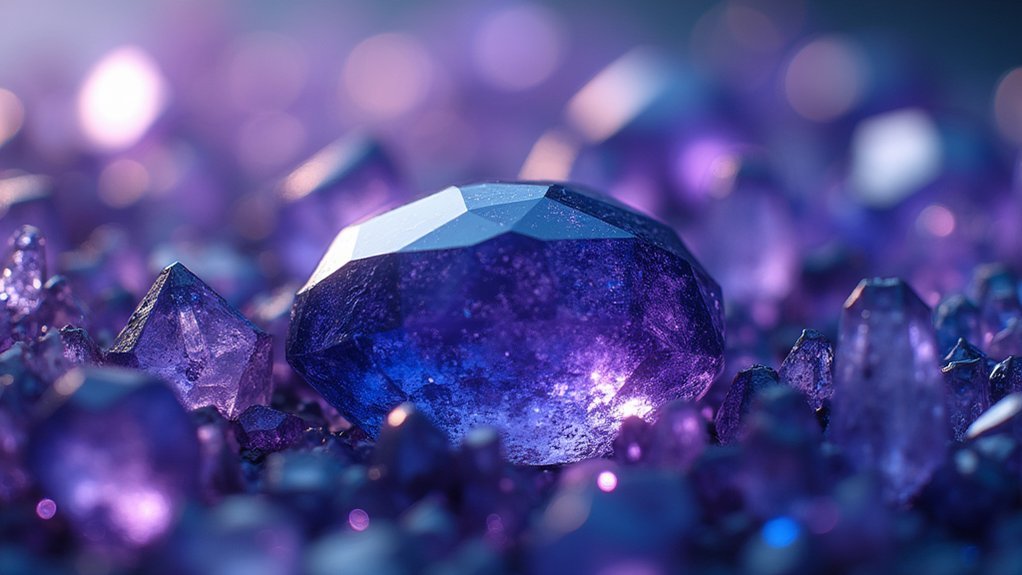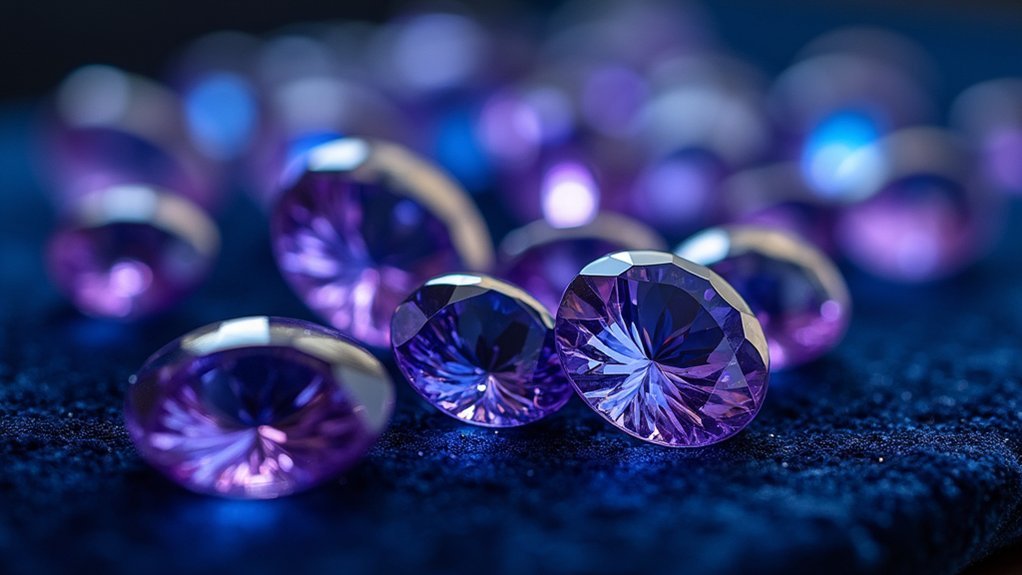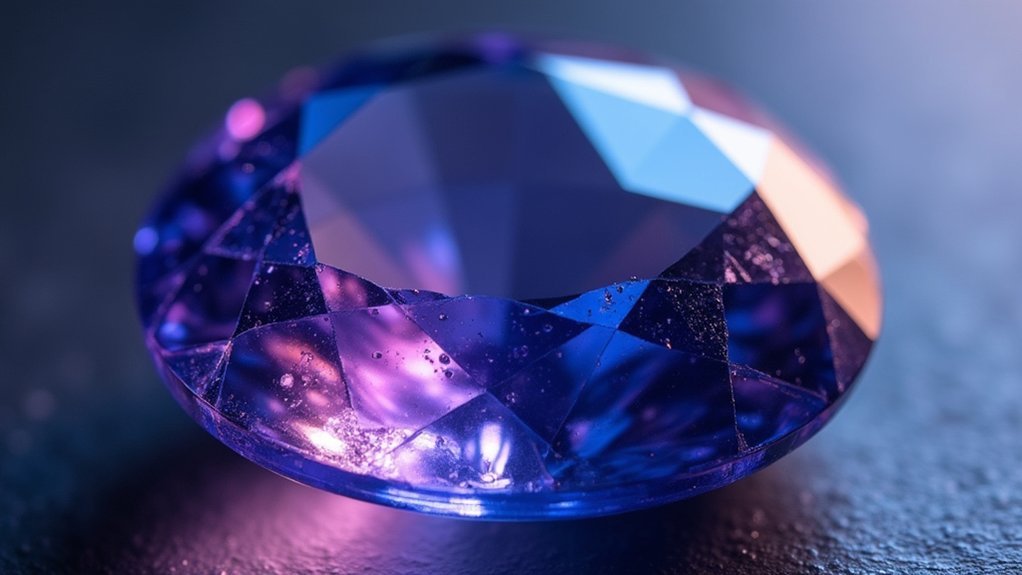Tanzanite’s color grading depends on its pleochroic properties, showing blue, violet, and burgundy hues from different angles. Light conditions dramatically affect perception—natural daylight reveals true blue-violet tones, while incandescent light enhances violets. Factors influencing grading include mining location (Merelani Hills zones yield varying qualities), heat treatment status, vanadium content, and cut optimization. Proper evaluation requires examining stones under multiple light sources to appreciate their full color-changing potential.
The Science Behind Tanzanite’s Color Change Properties

While many gemstones display unique optical properties, tanzanite stands out for its remarkable pleochroism—a phenomenon that causes it to exhibit different colors when viewed from different angles.
This trichroic gemstone shifts between blue, violet, and burgundy, dramatically altering its appearance under various lighting conditions.
Trace elements, particularly vanadium, enhance tanzanite’s vivid hues and contribute to its distinctive color change effect.
Vanadium’s influence creates tanzanite’s captivating color-shifting magic, transforming ordinary crystals into treasures of remarkable optical complexity.
When conducting color grading, experts consider both the stone’s natural properties and improvements from heat treatment, which transforms brownish tones into the coveted blue-violet shades that increase market value.
Your tanzanite will look most impressive in natural daylight, which reveals its true saturation and depth.
The ideal specimens display medium to medium-dark tones with high saturation, ensuring the stone’s mesmerizing color shift is visible across all lighting environments.
Light Sources and Their Impact on Tanzanite Appearance
The same tanzanite gemstone can transform dramatically under different light sources, revealing why proper illumination matters when evaluating these rare gems. This pleochroism effect means you’ll see markedly different color presentations depending on your lighting environment.
Natural daylight showcases tanzanite’s vibrant blue-violet hues at their richest, while incandescent light enhances violet tones but may diminish blue depth. Fluorescent lighting typically washes out tanzanite’s color, resulting in duller appearance and reduced saturation.
During color grading, light temperature plays an essential role—warmer lights bring out red and violet undertones, while cooler lights emphasize blue characteristics.
To guarantee accurate assessment of a tanzanite’s true hue and saturation, professionals always grade these gems under standardized lighting conditions, preventing misleading evaluations caused by inappropriate light sources.
Crystal Structure and Pleochroism in Tanzanite

Understanding tanzanite’s remarkable color-changing abilities requires knowledge of its distinctive crystal structure. The gemstone’s unique hexagonal formation creates strong pleochroism, allowing you to see different colors—typically blue, violet, and burgundy—depending on your viewing angle.
When evaluating tanzanite’s quality and market value, this pleochroism becomes vital. For proper color grading, examine the stone under natural lighting conditions from multiple angles.
Remember that blue-dominant tanzanite (containing at least 51% blue) commands the highest value in the market.
For investors and collectors alike, tanzanite’s value peaks when blue dominates its pleochroic display.
The optical properties causing these color variations aren’t just fascinating—they’re fundamental to accurate appraisal. You’ll notice the intensity of pleochroism affects how you perceive the overall color, making the viewing perspective an essential factor when determining a tanzanite’s true quality and worth.
Heat Treatment Effects on Color Expression
Nearly all tanzanite on the market today has undergone heat treatment, a process that transforms the gemstone’s original brownish tones into the coveted blue-violet hues collectors prize.
This enhancement considerably impacts color grading, often elevating stones to higher classifications under GIA standards by increasing saturation levels and intensifying color expression.
- Heat treatment dramatically improves tanzanite’s overall appeal, making it more marketable while maintaining its fundamental properties.
- Untreated stones are exceptionally rare and command premium market values due to their scarcity.
- The heating process can simultaneously improve clarity by reducing the visibility of certain inclusions.
- You’ll always want to inquire about treatment status when purchasing tanzanite, as this affects both authenticity and value.
Trace Elements That Influence Tanzanite Hues

While tanzanite’s extraordinary color transformation through heat treatment captures much attention, specific trace elements within the crystal structure fundamentally determine its potential color range.
Vanadium serves as the primary chromophore, enhancing the blue coloration that makes tanzanite so coveted. Chromium works alongside vanadium, adding depth and richness to the violet hues that dance through the gem.
Vanadium creates the signature blue, while chromium enriches tanzanite’s violet depths in perfect elemental harmony.
You’ll notice that the finest tanzanite displays a delicate balance of these trace elements. Iron, however, can diminish color quality by introducing unwanted brownish tints.
The varying concentrations of these elements directly impact both saturation and tone in the final stone. When heat treatment is applied, it optimizes how these trace elements interact within the crystal, revealing the full potential of tanzanite’s remarkable color spectrum.
Evaluating Color Saturation and Tone Variations
When examining a Tanzanite’s value, you’ll need to assess its saturation on the 1-6 scale, where higher grades indicate more vivid blue coloration worth premium prices.
You can observe dramatic shifts in color intensity under different lighting conditions, with daylight often revealing bluish tones while incandescent light brings out purple hues.
The stone’s ideal tone should fall between 4-6 on the 2-8 scale, as too light (2-3) or too dark (7-8) specimens diminish the gemstone’s visual appeal and market value.
Saturation Intensity Spectrum
The richness of a tanzanite’s color directly correlates with its market value, making saturation intensity a crucial factor in the grading process.
When you’re evaluating this remarkable gemstone, understanding the spectrum from grade 1 (brownish/grayish) to grade 6 (vivid blue-violet) helps you appreciate why higher saturation commands premium prices.
- A tanzanite’s saturation intensity is most desirable when it displays strong color concentration without appearing too dark or too light.
- Ideal tones (levels 4-6) complement high saturation by allowing the color’s brilliance to shine through.
- Pleochroism causes variations in saturation as you view the stone from different angles.
- The most valuable tanzanites display intense saturation with minimal gray or brown modifiers, creating that coveted vibrant appearance.
Lighting Effects Analysis
Light sources dramatically transform tanzanite’s appearance, making proper illumination essential for accurate color assessment.
When evaluating tanzanite, you’ll notice saturation appears enhanced under incandescent lighting but diminishes with fluorescent sources, altering your perception of the gem’s true quality.
For reliable color grading, examine stones in natural light, which reveals authentic hue and saturation levels without artificial enhancement.
The gem’s pleochroism compounds this challenge, as viewing angles reveal different colors depending on lighting conditions.
Tone variations are particularly susceptible to lighting influence—a moderately toned tanzanite might appear excessively dark in dim settings or washed out under intense illumination.
To determine a stone’s genuine characteristics, you should evaluate it under multiple lighting environments, noting how perceived color shifts between bright daylight and interior lighting.
Regional Mining Differences and Color Quality

When examining Tanzanite specimens, you’ll notice distinct color variations based on their Merelani Hills origin, with stones from certain zones displaying richer blue-violet saturation.
The geological composition in specific mining blocks, particularly in the deeper D-Block, yields Tanzanite with superior color quality compared to stones extracted from shallower areas.
Your ability to identify these zone-specific color intensities will greatly enhance your grading accuracy, as premium specimens typically emerge from areas with higher vanadium concentrations and ideal crystallization conditions.
Merelani Hills Variations
Nestled within Tanzania’s Merelani Hills lies the world’s only source of tanzanite, where distinct mining zones produce remarkably different color qualities.
When you’re examining tanzanite specimens, you’ll notice that stones from certain areas display the coveted vibrant violetish-blue, while others show duller or browner hues.
These regional variations stem from specific geological conditions that influenced the gemstone’s formation.
- The depth of mining impacts color saturation and tone, with different levels yielding unique tanzanite characteristics.
- Surrounding minerals in the soil directly affect the color development and quality of extracted stones.
- Some zones consistently produce fine-quality tanzanite with superior color intensity.
- As mining progresses, higher-grade tanzanite becomes increasingly scarce, making location knowledge essential for collectors.
Understanding these Merelani Hills variations helps you make informed decisions when purchasing this rare gemstone.
Zone-Specific Color Intensity
The four distinct mining zones within Tanzania’s Merelani Hills each produce tanzanite with signature color characteristics that collectors and gem enthusiasts can identify.
You’ll notice the southern zone yields tanzanite with remarkably deep saturation and vibrant violetish-blue hues, while northern zone specimens typically display more muted tones.
Mining depth greatly influences color intensity—stones extracted from deeper sections often exhibit the most coveted rich colors due to minimal environmental exposure.
This correlation between depth and color quality isn’t coincidental; it’s driven by specific geological conditions unique to each area. The mineral composition varies across zones, directly affecting color development during formation.
Savvy buyers should understand how harvesting practices in different zones impact the final product.
When evaluating tanzanite quality, always consider its origin within the Merelani Hills as a key indicator of potential color intensity.
Cut Optimization for Maximum Color Display
Because tanzanite exhibits strong pleochroism, cutting decisions fundamentally shape how the gem’s color will appear to admirers.
When you’re evaluating tanzanite quality, understanding cut optimization is essential for appreciating why some stones display superior color than others. Cutters must balance maximizing the desirable blue-violet hues with financial considerations, as improper orientation can diminish both value and visual appeal.
- Cutting direction determines which color axis faces up—with proper orientation showcasing the richest blues and purples
- Proportions of the cut affect light return and brilliance, enhancing the gem’s overall color saturation
- Violet-purple variants are more frequently available because they’re easier to optimize during cutting
- Weight retention often competes with color optimization, as cutters must balance profit margins against ideal color display
Frequently Asked Questions
What Is the Best Color Grade for Tanzanite?
The best color grade for tanzanite is vB 6/6 on the GIA scale. You’ll want a vivid violetish-blue stone with medium to medium-dark tone and high saturation, typically found in larger gems.
How Does Tanzanite Change Color?
Tanzanite changes color through pleochroism – you’ll see different hues (blue, violet, or burgundy) as you rotate the stone. Heat treatment also transforms brownish stones into vibrant blue-violet gems that you’ll find more valuable.
What Is the Grading System for Tanzanite?
The GIA grades tanzanite on a three-part scale: Hue (color), Tone (lightness/darkness), and Saturation (purity). You’ll see this expressed as “vB 6/6” format, with violetish-Blue (vB) being the most valued hue.
What Is the Difference Between AAA and AAAA Tanzanite?
AAA tanzanite offers high saturation and clarity, while AAAA claims superior blue-violet color and exceptional clarity. You’ll find this grading isn’t standardized though, so don’t rely solely on these designations when purchasing.
In Summary
You’ve seen how tanzanite’s remarkable color-shifting ability stems from its unique crystal structure and pleochroism. When you’re evaluating a stone, remember that lighting conditions, heat treatment history, and proper cutting all dramatically affect what you’ll observe. By understanding these change factors, you’ll make more informed decisions when purchasing tanzanite, ensuring you’re getting the vibrant blue-purple gem you desire with peak color performance.





Leave a Reply